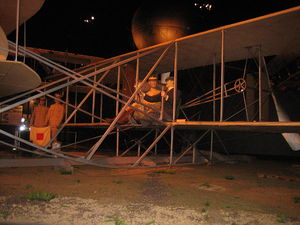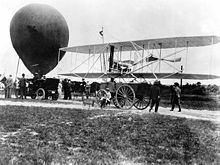Wright Model A Video - Picture
More Aviation History

|
|
Wright Model A
Wright Model A/Military Flyer

Picture - A replica Wright Military Flyer at the National Museum of the United States Air Force
Role: Demonstrator
Manufacturer: Wright Company
First flight: 1908
Number built: ca.60
Unit cost: $25,000 plus $5,000 bonus (first 1909 Military Flyer only)
The Wright Model A was an early aircraft produced by the Wright Brothers in the United States beginning in 1906. It was an outgrowth of their Flyer III airplane of 1905. The Wrights actually built about seven Model As in their bicycle shop during their interim period 1906-1907 in which they did no flying. One of these was shipped to Le Havre in 1907 in anticipation of it being demonstrated for the French. The Model A had a 35 horsepower (26 kW) engine and seating for two with new control arrangement. Otherwise it was identical to the 1905 airplane. The Model A was the first aircraft that they offered for sale, and the first aircraft design to enter serial production anywhere in the world. Apart from the seven machines the Wrights built themselves in 1906-1907, they sold licences for production in Europe, with the largest number of Model As actually being produced in Germany by Flugmaschine Wright GmbH, which built about 60 examples.
The 1909 Military Flyer was a one-of-a-kind Model A built by the Wright Brothers. With wings shortened two feet and the same engine salvaged from the wrecked 1908 Fort Myer Flyer, it differed from the standard Wright A in size and had a faster speed. The aircraft was demonstrated successfully at Fort Myer, Virginia beginning June 28, 1909 for the U.S. Army Signal Corps, which offered a contract of $25,000 ($609,074 in present-day terms) for an aircraft capable of flying at 40 miles per hour (64 km/h) with two people on board for a distance of 125 miles (201 km). After rigid trials the Signal Corps accepted the airplane, August 2, 1909, paying the brothers $30,000 ($730,889 in present-day terms).
Individual Control Arrangement
Wilbur & Orville devised slightly different flight controls in the Model A airplanes they built separately in France and the United States for their 1908 & 1909 public demonstrations. The Smithsonian's National Air and Space Museum refers to "The Wilbur Method" and "The Orville Method". In Wilbur's method, the roll and yaw controls were combined on the same lever at the pilot's right hand. A forward-backward movement controlled the rudder, while a sideways or left-and-right motion controlled wing-warping. In the Orville Method, moving the stick controlled wing-warping, while a knob atop the stick controlled the rudder. In both methods the left-hand lever operated the forward elevator to control pitch. Wilbur trained French and Italian pilots using his method, and Orville trained German pilots while in Germany in 1909 for the Wright GmbH as well as American pilots at the Wright Company flight school using his method.
Survivors
Wright Flyer III, was itself the prototype in 1908. Flyer III was restored in the late 1940s back into its original 1905 configuration.
The original Wright Military Model A plane is now on display at the National Air and Space Museum in Washington, DC. It is displayed in much the original condition as when the Smithsonian received it in 1911.
The only original standard model A to survive, and the sole surviving original Dayton built example, is the one Orville Wright used to demonstrate at Tempelhof, Germany in September 1909. It resides in the Deutsches Museum, Munich.
Reproductions
An exact reproduction of the 1909 Military Flyer is on display in the National Museum of the United States Air Force in Dayton, Ohio. This reproduction was constructed in 1955 by Museum personnel. It is equipped with an original engine personally donated for the reproduction by Orville Wright, while the chains, sprockets, and propellers were all donated by the heirs of the Wright estate, and have been added to the replica as they have been received and restored.
In 2008 Ken Hyde built an exact replica of the original 1908 Wright Model A Military Flyer which itself was one of the Dayton 7. This for 100th anniversary and remembrance of Orville Wright's first trip to Fort Myer and also the death of Thomas Selfridge. Hyde has said in press reports that his reproduction is flyable but for now it will only exist in static display.

Picture - The Wright 1908 Model A Military Flyer arrives at Fort Myer, Virginia aboard a wagon, attracting the attention of children and adults.
Operators
United States
United States Army
Specifications (Wright Military Flyer)
Data from "US Army Aircraft 1908-1946" by James C. Fahey, 1946, 64pp.
General characteristics
Crew: Two
Length: 30 ft 8 in (9.32 m)
Wingspan: 36 ft 5 in (11.09 m)
Height: 8 feet (2.43 m)
Empty weight: 740 lb (336 kg)
Loaded weight: 1,263 lb (573 kg)
Powerplant: 1x— Wright Model 4, 35 hp (26 kW)
Performance
Maximum speed: 42 mph (67.6 km/h)
aeroflight.co.uk
United States Air Force Museum (1975 edition)
More airplanes.
Source: WikiPedia